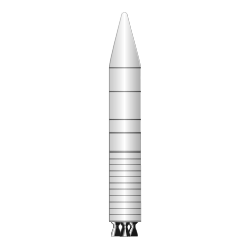
An intercontinental ballistic missile (ICBM) is a ballistic missile with a range greater than 5,500 kilometres (3,400 mi), primarily designed for nuclear weapons delivery. Conventional, chemical, and biological weapons can also be delivered with varying effectiveness, but have never been deployed on ICBMs. Most modern designs support multiple independently targetable reentry vehicle (MIRVs), allowing a single missile to carry several warheads, each of which can strike a different target. The United States, Russia, China, France, India, the United Kingdom, Israel, and North Korea are the only countries known to have operational ICBMs.
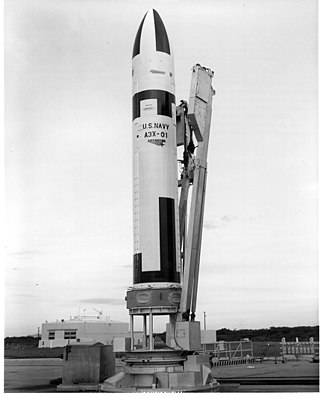
The UGM-27 Polaris missile was a two-stage solid-fueled nuclear-armed submarine-launched ballistic missile (SLBM). As the United States Navy's first SLBM, it served from 1961 to 1980.

A ballistic missile (BM) is a type of missile that uses projectile motion to deliver warheads on a target. These weapons are powered only during relatively brief periods—most of the flight is unpowered. Ballistic missiles differs in range; short-range ballistic missiles (SRBM) stay within the Earth's atmosphere, while intercontinental ballistic missiles (ICBM) are launched on a sub-orbital flight. They are internally guided, those for short range are typically inertial-guided while those for long range typically have more sophisticated guidance.
A ballistic missile submarine is a submarine capable of deploying submarine-launched ballistic missiles (SLBMs) with nuclear warheads. These submarines became a major weapon system in the Cold War because of their nuclear deterrence capability. They can fire missiles thousands of kilometers from their targets, and acoustic quieting makes them difficult to detect, thus making them a survivable deterrent in the event of a first strike and a key element of the mutual assured destruction policy of nuclear deterrence. The deployment of ballistic missile submarines is dominated by the United States and Russia. Smaller numbers are in service with France, the United Kingdom, China and India; North Korea is also suspected to have an experimental submarine that is diesel-electric powered.

The PGM-17A Thor was the first operative ballistic missile of the United States Air Force (USAF). It was named after the Norse god of thunder. It was deployed in the United Kingdom between 1959 and September 1963 as an intermediate-range ballistic missile (IRBM) with thermonuclear warheads. Thor was 65 feet (20 m) in height and 8 feet (2.4 m) in diameter.
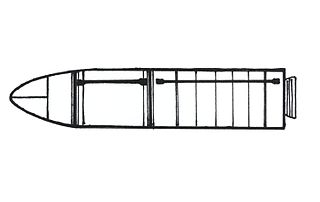
The M4 was a French submarine-launched ballistic missile (SLBM) deployed on the nuclear Redoutable-class submarines.
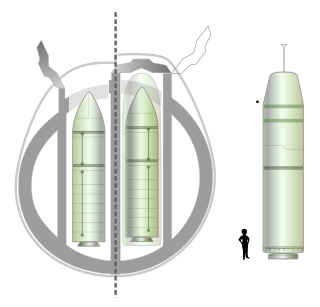
The M45 SLBM was a French Navy submarine-launched ballistic missile Forty-eight M45 were in commission in the Force océanique stratégique, the submarine nuclear deterrent component of the French Navy. The missiles, derived from the M4, were produced by Aérospatiale. Initially, an ICBM land-based version was considered, but these plans were discarded in 1996 to favour an all-naval deployment.

The UGM-133A Trident II, or Trident D5 is a submarine-launched ballistic missile (SLBM), built by Lockheed Martin Space in Sunnyvale, California, and deployed with the United States and Royal Navy. It was first deployed in March 1990, and remains in service. The Trident II Strategic Weapons System is an improved SLBM with greater accuracy, payload, and range than the earlier Trident C-4. It is a key element of the U.S. strategic nuclear triad and strengthens U.S. strategic deterrence. The Trident II is considered to be a durable sea-based system capable of engaging many targets. It has payload flexibility that can accommodate various treaty requirements, such as New START. The Trident II's increased payload allows nuclear deterrence to be accomplished with fewer submarines, and its high accuracy—approaching that of land-based missiles—enables it to be used as a first strike weapon.

The Le Redoutable-class submarine was a ballistic missile submarine class of the French Navy. In French, the type is called Sous-marin Nucléaire Lanceur d'Engins (SNLE), literally "Missile-launching nuclear submarine". When commissioned, they constituted the strategic part of the naval component of the French nuclear triad, then called Force de frappe.
The M51 SLBM is a French submarine-launched ballistic missile, built by ArianeGroup, and deployed with the French Navy. Designed to replace the M45 SLBM, it was first deployed in 2010.

Le Redoutable was the lead boat of her class of ballistic missile submarines in the French Marine Nationale.

The M1 MSBS was the first French submarine-launched ballistic missile.

The RSM-56 Bulava is a submarine-launched ballistic missile (SLBM) developed for the Russian Navy and deployed in 2013 on the new Borei class of ballistic missile nuclear submarines. It is intended as the future cornerstone of Russia's nuclear triad, and is the most expensive weapons project in the country. The weapon takes its name from bulava, a Russian word for mace.

A nuclear triad is a three-pronged military force structure of land-based intercontinental ballistic missiles (ICBMs), submarine-launched ballistic missiles (SLBMs), and strategic bombers with nuclear bombs and missiles. Countries build nuclear triads to eliminate an enemy's ability to destroy a nation's nuclear forces in a first-strike attack, which preserves their own ability to launch a second strike and therefore increases their nuclear deterrence.
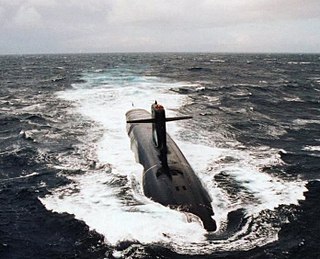
The Triomphant class of ballistic missile submarines of the French Navy is the active lead boat class of four boats that entered service in 1997, 1999, 2004, and 2010. These four superseded the older Redoutable class, and they provide the ocean-based component of France's nuclear deterrent strike force, the Force de dissuasion. Their home port is Île Longue, Roadstead of Brest, Western Brittany.

The S3 was a French land-based Intermediate Range Ballistic Missile, equipped with a single 1.2-megatonne thermonuclear warhead. In France it is called an SSBS, for Sol-Sol Balistique Stratégique, or Ground-Ground Strategic Ballistic Missile.
K-4 is a nuclear capable Intermediate-range submarine-launched ballistic missile developed by the Defence Research and Development Organisation of India to arm the Arihant-class submarines. The missile has a maximum range of about 4000 km.
The Pukguksong-1 or Pukkŭksŏng-1, Bukgeukseong-1, alternatively KN-11 in intelligence communities outside North Korea, is a North Korean, two-stage submarine-launched ballistic missile (SLBM) that was successfully flight tested on 24 August 2016.
The M2 MSBS was the second French submarine-launched ballistic missile. In French, MSBS is the abbreviation for Mer-Sol Balistique Stratégique, or Sea-Ground Strategic Ballistic Missile. It has two stages. It was deployed on the Redoutable-class SNLEs or SSBNs from 1974 to 1978, replacing the M1 MSBS. The M2 was itself replaced by the M20 MSBS beginning in 1977.
